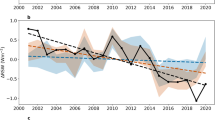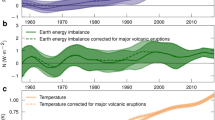Abstract
The evolution of the Earth's climate has been extensively studied1,2, and a strong link between increases in surface temperatures and greenhouse gases has been established3,4. But this relationship is complicated by several feedback processes—most importantly the hydrological cycle—that are not well understood5,6,7. Changes in the Earth's greenhouse effect can be detected from variations in the spectrum of outgoing longwave radiation8,9,10, which is a measure of how the Earth cools to space and carries the imprint of the gases that are responsible for the greenhouse effect11,12,13. Here we analyse the difference between the spectra of the outgoing longwave radiation of the Earth as measured by orbiting spacecraft in 1970 and 1997. We find differences in the spectra that point to long-term changes in atmospheric CH4, CO2 and O3 as well as CFC-11 and CFC-12. Our results provide direct experimental evidence for a significant increase in the Earth's greenhouse effect that is consistent with concerns over radiative forcing of climate.
This is a preview of subscription content, access via your institution
Access options
Subscribe to this journal
Receive 51 print issues and online access
$199.00 per year
only $3.90 per issue
Buy this article
- Purchase on Springer Link
- Instant access to full article PDF
Prices may be subject to local taxes which are calculated during checkout

Similar content being viewed by others
References
Houghton, J., Jenkins, G. & Ephraums, J. (eds) Climate Change: The IPCC Scientific Assessment (Cambridge Univ. Press, Cambridge, 1990).
Houghton, J. et al. (eds) Climate Change 1995: The Science of Climate Change (Cambridge Univ. Press, Cambridge, 1995).
Mitchell, J., Johns, T., Gregory, J. & Tett, S. Climate response to increasing levels of greenhouse gases and sulphate aerosols. Nature 376, 501–505 (1995).
Tett, S., Stott, P., Allen, M., Ingram, W. & Mitchell, J. Causes of twentieth century temperature change near the Earth's surface. Nature 399, 569–575 (1999).
Cess, R. et al. Interpretation of cloud-climate feedback predicted by 14 atmospheric general circulation models. Science 245, 513–516 (1989).
Rind, D. et al. Positive water vapour feedback in climate models confirmed by satellite observations. Nature 349, 500–503 (1991).
Lindzen, R. Some coolness regarding global warming. Bull. Am. Meteorol. Soc. 71, 288–299 (1990).
Goody, R., Haskins, R., Abdou, W. & Chen, L. Detection of climate forcing using emission spectra. Earth Observ. Remote Sensing 13, 713–722 (1995).
Harries, J., Brindley, H. & Geer, A. Climate variability and trends from operational satellite spectral data. Geophys. Res. Lett. 25, 3975–3978 (1998).
Goody, R., Anderson, J. & North, G. Testing climate models: an approach. Bull. Am. Meteorol. Soc. 79, 2541–2549 (1998).
Slingo, A. & Webb, M. The spectral signature of global warming. Q. J. R. Meteorol. Soc. 123, 293–307 (1996).
Clough, S., Iacono, M. & Moncet, J.-L. Line-by-line calculations of atmospheric fluxes and cooling rates: Application to water vapor. J. Geophys. Res. 97, 15761–15785 (1992).
Clough, S. & Iacono, M. Line-by-line calculation of atmospheric fluxes and cooling rates: 2. Application to carbon dioxide, methane, nitrous oxide and the halocarbons. J. Geophys. Res. 100, 16519–16535 (1995).
IMG mission operation and verification committee. Interferometric Monitor for Greenhouse Gases (ed. Kobayashi, H.) (IMG Project Technical Report, Central Research Institute of Electric Power Industry (CRIEPI), Komae Research Laboratory, Komae-shi, Tokyo, 1999).
Hanel, R., Schlachman, B., Rogers, D. & Vanous, D. Nimbus 4 Michelson interferometer. Appl. Opt. 10, 1376–1382 (1971).
Strabala, K., Ackerman, S. & Menzel, W. Cloud properties inferred from 8-12 µm data. J. Appl. Meteorol. 33, 212–229 (1994).
Scientific Assessment of Ozone Depletion: 1998 Ch. 4 (Report No. 44, Global Ozone Research and Monitoring Project, World Meteorological Organization, Geneva, 1999).
Oort, A. & Liu, H. Upper air temperature trends over the globe. 1958-1989. J. Clim. 6, 292–307 (1993).
Kalnay, E. et al. The NCEP/NCAR 40-year re-analysis project. Bull. Am. Meteorol. Soc. 77, 437–471 (1996).
Randel, W. & Wu, F. A stratospheric ozone trends data set for global modeling studies. Geophys. Res. Lett. 26, 3089–3092 (1999).
Olivier, J. et al. Description of EDGAR Version 2.0: A Set of Global Emission Inventories of Greenhouse Gases and Ozone-depleting Substances for all Anthropogenic and Most Natural Sources on a Per Country Basis and on a 1 Deg x 1 Deg Grid (RIVM Report No. 771060 002 and TNO-MEP Report No. R96/119, National Institute of Public Health and the Environment, Bilthoven, The Netherlands, 1996).
Berk, A., Bernstein, L. & Robertson, D. MODTRAN: a Moderate Resolution Model for LOWTRAN 7 (AFGL-TR-88-0177, US Air Force Geophysics Laboratory, Hanscom Air Force Base, Massachusetts, 1989).
Hanel, R. et al. The Nimbus 4 infrared spectroscopy experiment 1. Calibrated thermal emission spectra. J. Geophys. Res. 77, 2629–2641 (1972).
Shettle, E. P. in Atmospheric Propagation in the UV, Visible, IR and MM-wave Region and Related System Aspects 15-1–15-12 (AGARD-CP-454, Air Force Geophysics Lab., Bedford, Massachusetts, 1990).
Ackerman, S., Smith, W., Spinhirne, J. & Revercomb, H. The 27-28 October 1986 FIRE IFO cirrus case study: spectral properties of cirrus cloud in the 8-12 um window. Mon. Weath. Rev. 118, 2377–2388 (1990).
Bantges, R., Russell, J. & Haigh, J. Cirrus cloud top-of-atmosphere radiance spectra in the thermal infrared. J. Quant. Spectrosc. Radiat. Transfer 63, 487–498 (1999).
Chamberlain, J. The Principles of Interferometric Spectroscopy (Wiley, Chichester, 1979).
Acknowledgements
We thank L. Chen and R. Goody for providing access to IRIS data, and S. Taguchi and H. Kobayashi for providing access to IMG data.
Author information
Authors and Affiliations
Corresponding author
Rights and permissions
About this article
Cite this article
Harries, J., Brindley, H., Sagoo, P. et al. Increases in greenhouse forcing inferred from the outgoing longwave radiation spectra of the Earth in 1970 and 1997. Nature 410, 355–357 (2001). https://doi.org/10.1038/35066553
Received:
Accepted:
Issue Date:
DOI: https://doi.org/10.1038/35066553
This article is cited by
-
Band-by-band spectral radiative kernels based on the ERA5 reanalysis
Scientific Data (2024)
-
Trends in spectrally resolved outgoing longwave radiation from 10 years of satellite measurements
npj Climate and Atmospheric Science (2021)
-
Spatial and temporal variability of free gas content in shallow sediments: Lake Kinneret as a case study
Geo-Marine Letters (2020)
-
Monitoring spatial pattern of land surface thermal characteristics and urban growth: A case study of King Williams using remote sensing and GIS
Earth Science Informatics (2019)
-
Unmasking the negative greenhouse effect over the Antarctic Plateau
npj Climate and Atmospheric Science (2018)
Comments
By submitting a comment you agree to abide by our Terms and Community Guidelines. If you find something abusive or that does not comply with our terms or guidelines please flag it as inappropriate.



